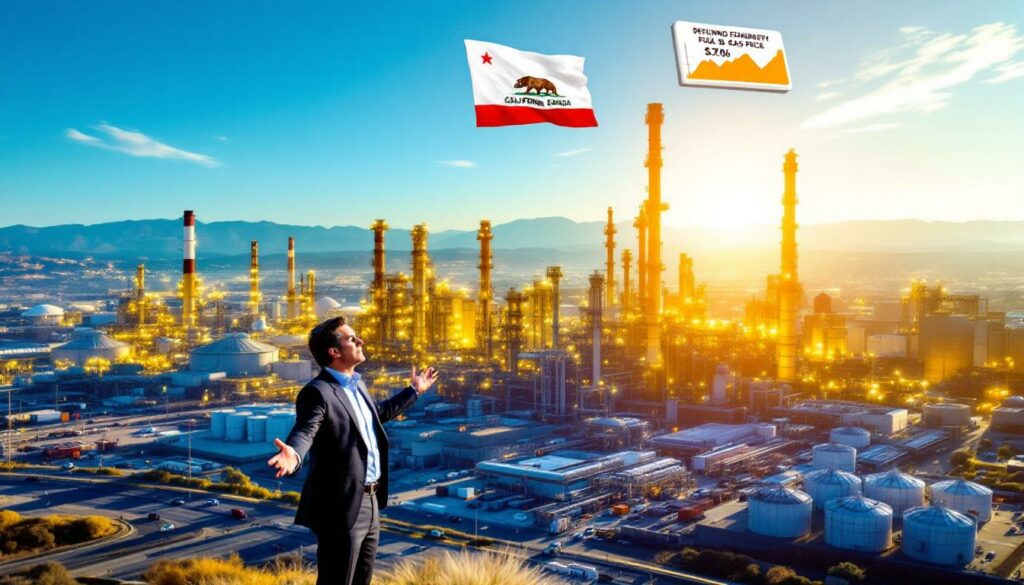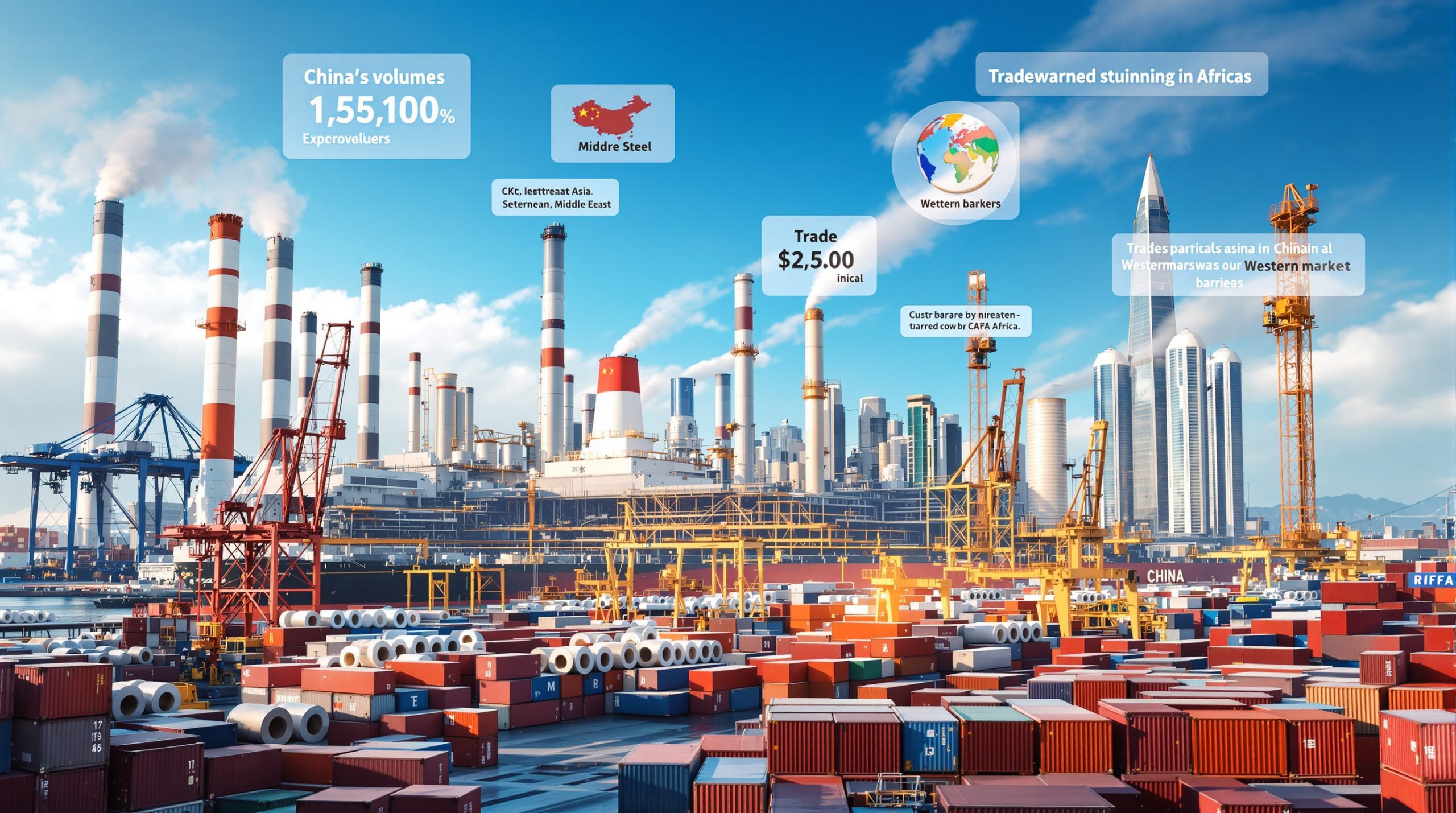Why Did California's Governor Intervene to Save the Valero Refinery?
The recent intervention by California Governor Gavin Newsom to prevent the closure of Valero's critical refinery marks a significant moment in the state's ongoing energy security transition. The refinery, which processes approximately 145,000 barrels of crude oil daily, represents a substantial portion of California's fuel production capacity at a time when the state has already lost 12% of its refining infrastructure since 2020.
The decision to intervene came as analysts warned of potential fuel price spikes ranging from $0.25 to $0.75 per gallon if the facility were to close, creating ripple effects throughout California's economy. The state's unique "fuel island" status makes it particularly vulnerable to supply disruptions, with limited pipeline connections to other regions and specialized fuel requirements that cannot be easily substituted.
"California's isolation from other U.S. refining centers means even a single refinery closure can trigger significant market volatility," noted energy analyst James Burkhard in his assessment of the situation. "The Valero facility represents more than just production capacity—it's a critical node in Northern California's fuel security network."
Unlike other states that can quickly receive fuel shipments through extensive pipeline networks, California's geographic isolation and specialized fuel formulations create a precarious supply situation that Governor Newsom determined could not withstand further refining capacity losses.
What Led to the Valero Refinery Crisis in California?
The Economic and Regulatory Pressures on California Refineries
California's refineries operate under what industry analysts call a "regulatory premium"—a complex web of environmental requirements that create significant compliance costs not faced by facilities in other states. The Low Carbon Fuel Standard (LCFS) alone has generated compliance costs that reached approximately $200 per ton credit by 2024, adding substantial production expenses.
The state's cap-and-trade program further increases operational costs by an estimated $0.10-$0.15 per gallon compared to refineries in states without such programs. When combined with California's specialized fuel formulation requirements, these factors create what one industry analysis termed a "30% cost disadvantage versus Gulf Coast counterparts."
"California refiners essentially operate in a different economic universe than their competitors," explained Dr. Amy Myers Jaffe, managing director of the Climate Policy Lab at Tufts University. "They're simultaneously meeting the world's most stringent environmental standards while competing with facilities that don't bear those same costs."
These economic pressures have already led to several refinery closures, including Phillips 66's 2022 conversion of its Martinez facility, which eliminated 161,000 barrels per day of conventional fuel production capacity. The threatened Valero closure would have continued this concerning trend at a time when the state's transition to alternative fuels remains incomplete.
How Would a Refinery Closure Impact California's Fuel Market?
Potential Market Disruptions and Price Volatility
The closure of Valero's refinery would have created an immediate supply shortfall of approximately 3 million gallons of gasoline and diesel daily. Northern California would have borne the brunt of this disruption, as the region relies on Valero for nearly 50% of its fuel supply, according to California Energy Commission data.
Price effects would have been both severe and immediate. The supply gap couldn't be quickly filled through imports due to California's limited import terminal capacity of just 1.2 million barrels daily and the specialized nature of California's fuel blends. Analysts projected price increases of $0.25-$0.75 per gallon, with potentially higher spikes during peak demand periods, contributing to significant oil price movements.
Table: Projected Impacts of Valero Refinery Closure
| Impact Area | Projected Effect | Primary Reason |
|---|---|---|
| Supply Shortfall | 3 million gallons/day | Limited replacement options |
| Price Increase | $0.25-$0.75 per gallon | Supply-demand imbalance |
| Regional Impact | Severe in Northern CA | 50% supply reliance |
| Duration | 3-6 months minimum | Import infrastructure limitations |
| Vulnerable Sectors | Transportation, agriculture | Diesel dependency |
California's Vulnerable Fuel Supply Chain
California's fuel vulnerability stems from multiple structural factors that create what energy analysts call a "perfect storm" for supply disruptions:
- Geographic isolation from other major U.S. refining centers
- Limited pipeline connections to neighboring states (primarily from Washington)
- Specialized CARBOB gasoline requirements that cannot be easily substituted
- Marine terminal constraints requiring 14-day advance scheduling for imports
- Just-in-time inventory practices providing only 10 days of gasoline buffer
These vulnerabilities were starkly demonstrated during the 2015 Torrance refinery outage, which caused gasoline prices to surge by $0.60 per gallon overnight. The California Energy Commission's subsequent analysis determined that the state's refining capacity operated with "minimal redundancy," leaving consumers exposed to supply disruptions.
What Actions Did Governor Newsom Take to Prevent the Closure?
The Governor's Intervention Strategy
Facing the prospect of significant fuel price increases and supply disruptions, Governor Newsom implemented a multi-faceted approach through Executive Order N-12-25, which invoked emergency powers under California Government Code §8625. The intervention included:
- Temporary regulatory relief from certain Low Carbon Fuel Standard credit requirements
- Expedited permitting processes that reduced maintenance approval timelines from weeks to 72 hours
- Tax considerations to improve short-term economic viability, including deferral options
- Logistics coordination to ensure adequate transportation support for continued operations
A senior Newsom administration official characterized the move as "a tactical retreat, not a surrender of climate goals," emphasizing the temporary nature of the accommodations. The intervention drew comparisons to similar emergency measures implemented during the 2022 Olympic Dam refinery fire, which temporarily waived certain fuel specifications to prevent market disruptions.
Balancing Environmental Goals with Energy Security
The governor's intervention highlighted the delicate balance California must maintain between ambitious climate objectives and immediate energy export challenges. The state remains committed to its 2035 zero-emission vehicle mandate while recognizing that the existing vehicle fleet will require conventional fuels for years to come.
"California's energy transition requires managing two parallel systems simultaneously," noted energy economist Severin Borenstein of UC Berkeley. "You can't mandate EVs without ensuring affordable energy for the transition fleet that will remain on roads for decades."
This pragmatic approach acknowledges that abrupt supply disruptions could undermine public support for climate policies if they create economic hardship for consumers. The administration emphasized that temporary accommodations were designed specifically to prevent market shocks while maintaining California's long-term environmental trajectory.
What Are the Broader Implications for California's Energy Future?
California's Refining Capacity Challenges
The near-closure of the Valero refinery underscores fundamental structural challenges in California's fuel market that will persist throughout the state's energy transition:
- California has lost over 450,000 barrels per day of refining capacity since 2015
- No new conventional refineries have been built in the state since 1979
- Existing facilities face limited capital investment due to regulatory uncertainty
- Import infrastructure remains constrained despite growing reliance on external sources
- Specialized fuel requirements create a 10-14 day supply delay for emergency imports
These trends suggest California will face recurring fuel supply vulnerabilities as its refining sector continues to contract. Energy security experts have noted that California's current policy framework lacks comprehensive contingency planning for these transition periods.
The Transition to Alternative Fuels and Electrification
While addressing immediate fuel supply concerns, California continues pursuing its aggressive renewable energy transformations:
- 100% zero-emission vehicle sales by 2035 (CARB mandate)
- Renewable diesel production has tripled since 2021 to 1.2 billion gallons annually
- Hydrogen fueling station network set to expand from 65 to 200 locations by 2030
- Electric vehicle charging infrastructure growing at 25% annually (CEC data)
Table: California's Alternative Fuel Transition Timeline
| Milestone | Target Date | Current Progress (2025) |
|---|---|---|
| ZEV Sales Mandate | 100% by 2035 | 28% of new vehicle sales |
| Public Charging Stations | 250,000 by 2030 | 87,000 installed |
| Hydrogen Fueling Stations | 200 by 2030 | 65 operational |
| Renewable Diesel Capacity | 2B gallons by 2030 | 1.2B gallons annually |
| Sustainable Aviation Fuel | 10% by 2035 | 3% of aviation fuel |
This transition requires careful management to avoid market disruptions and economic hardship. The Valero intervention demonstrates that California's path to decarbonization may include temporary accommodations to maintain system stability while alternative infrastructure develops.
How Does This Situation Compare to Previous Refinery Crises?
Historical Context of Refinery Interventions
The Valero intervention follows a pattern of government action during fuel supply emergencies, though with important distinctions:
- 2015 Torrance Refinery Fire: Temporary fuel specification waivers but no direct economic intervention
- 2012 Chevron Richmond Fire: Emergency response coordination but limited regulatory accommodation
- 2008 Supply Crisis: Strategic petroleum reserve release consideration during price spikes
What distinguishes the current intervention is its occurrence during an intentional energy transition rather than in response to an unplanned disruption. This marks a shift toward more proactive market management during California's decarbonization process.
Lessons from Other Regions Facing Refinery Closures
Other regions have navigated similar refining capacity contractions, offering potential lessons for California:
- Northeast U.S.: Lost 70% of refining capacity since 2000, developing robust import infrastructure and strategic reserves
- European Union: Managed 25% capacity reduction through coordinated transition planning and fuel security measures
- Japan: Created strategic inventory requirements for both public and private sectors to buffer supply disruptions
These experiences suggest California may need to develop more comprehensive fuel security protocols as its refining sector evolves, particularly enhanced storage requirements and expanded import capabilities to buffer future supply disruptions.
What Are the Economic Implications of the Governor's Decision?
Cost-Benefit Analysis of the Intervention
The economic case for intervention appears compelling when comparing potential costs against benefits:
- Avoided consumer costs: $500 million to $1.5 billion annually in prevented price increases
- Employment preservation: Approximately 500 direct jobs and 2,500 indirect positions
- Tax revenue maintenance: Estimated $75-100 million in annual state and local tax receipts
- Supply chain stability: Reduced disruption to transportation and agricultural sectors
Against these benefits, the intervention's costs appear relatively modest—primarily temporary regulatory flexibility rather than direct financial outlays. This favorable cost-benefit ratio likely influenced the governor's decision to act despite potential political tensions with environmental constituencies.
Impact on California's Business Climate and Energy Markets
The intervention sends mixed signals about California's business environment that may influence future investment decisions:
- Regulatory uncertainty: Creates questions about consistent enforcement of environmental standards
- Precedent considerations: Establishes expectations for potential future interventions
- Investment signals: May impact willingness to commit capital to conventional and alternative energy projects
- Market distortion concerns: Government intervention can create unintended market effects
Energy economist Danny Cullenward noted, "The question isn't whether this specific intervention was justified, but whether it represents a sustainable governance model for managing California's energy transition." This observation highlights the broader challenge of creating predictable market conditions during a period of transformative change.
How Are Stakeholders Responding to the Governor's Intervention?
Industry, Environmental, and Consumer Perspectives
The intervention has generated varied responses from different stakeholders, reflecting the complex tradeoffs involved amid global market uncertainty:
Industry Response:
- Refining sector welcomed the measures while emphasizing ongoing structural challenges
- Western States Petroleum Association called it "a necessary recognition of market realities"
- Energy traders noted the intervention created short-term price stability
Environmental Advocates:
- Mixed reactions, with concerns about precedent but acknowledgment of transition challenges
- Sierra Club expressed concern about "backsliding on climate commitments"
- Environmental Defense Fund offered qualified support, emphasizing the temporary nature
Consumer Groups:
- Consumer Watchdog supported the intervention as "preventing unnecessary price shocks"
- AAA projected average savings of $385-$725 annually per household from avoided price increases
- Transportation industry estimated $120 million in avoided fuel surcharges
Political Implications and Public Opinion
The political dimensions of the intervention reveal interesting cross-currents in California's energy politics:
- Bipartisan support: Rare agreement across political spectrum on preventing supply disruption
- Regional considerations: Strong support in Northern California where impacts would be most severe
- Demographic patterns: Lower-income communities most supportive due to fuel price sensitivity
- Generational divide: Younger voters more concerned about climate implications than price effects
Public polling showed 62% support for the intervention across California voters, though with significant regional and demographic variations. This broad support suggests energy security concerns can transcend typical political divides when consumer impacts are immediate and significant.
What Does This Mean for California's Climate Goals?
Reconciling Short-Term Energy Security with Long-Term Climate Objectives
The refinery intervention highlights important tensions in California's climate strategy that will require policy refinement:
- Transition timing: Recognition that infrastructure changes require careful sequencing
- Equity considerations: Ensuring low-income communities don't bear disproportionate transition costs
- Resilience planning: Building redundancy and flexibility during transition periods
- Policy integration: Better coordination between environmental regulations and energy security
Climate policy expert Michael Wara of Stanford University observed, "California is discovering that decarbonization isn't just about building the energy system of tomorrow—it's also about carefully dismantling the system of today." This insight underscores the need for more sophisticated transition management frameworks.
Adapting Climate Policies to Market Realities
The experience offers several lessons for climate policy implementation:
- Flexibility mechanisms: Building adaptive elements into regulatory frameworks
- Transition planning: Developing more detailed roadmaps for infrastructure evolution
- Market monitoring: Improving systems for anticipating supply disruptions
- Stakeholder engagement: Creating more inclusive processes for managing challenges
These adaptations could help California maintain progress toward its climate goals while minimizing market disruptions. The California Air Resources Board has already indicated it will conduct a "transition vulnerability assessment" to identify potential supply chain risks during the decarbonization process.
What Should Consumers and Businesses Expect Going Forward?
Near-Term Outlook for California's Fuel Markets
In the immediate aftermath of the intervention, California's fuel market outlook includes:
- Price stabilization: Prevention of the sharp increases that would have followed closure
- Supply adequacy: Maintained production levels supporting normal market operations
- Continued volatility risk: Ongoing vulnerability to other refinery disruptions
- Import dependence: Growing reliance on fuel imports from other regions
Consumers should expect relatively stable conditions compared to the potential disruption scenario, though California's structural price premium of approximately $0.80-$1.20 per gallon compared to national averages will persist due to underlying regulatory and logistical factors.
Long-Term Implications for Energy Costs and Availability
Looking further ahead, several trends will shape California's energy landscape:
- Gradual refining capacity reduction: Continued pressure on conventional fuel infrastructure
- Alternative fuel growth: Increasing availability of renewable diesel and other alternatives
- Electrification acceleration: Expanded charging infrastructure and EV adoption
- Price transition dynamics: Potential periods of volatility during infrastructure changes
These trends suggest a complex transition period where conventional fuels remain essential while alternatives gradually scale up. Energy economist James Hamilton projects, "We're likely entering a decade of heightened price volatility as California navigates between two energy paradigms."
FAQs About the California Refinery Intervention
Why are California's fuel prices typically higher than other states?
California's fuel prices exceed national averages due to several factors:
- Special CARBOB gasoline formulations required by state regulations
- Higher state fuel taxes and environmental fees (approximately $0.67 per gallon combined)
- Geographic isolation from other refining centers
- Limited pipeline connections to other markets
- Higher operational costs for in-state refineries due to regulatory compliance
These factors create a persistent price premium of approximately $0.80-$1.20 per gallon compared to national averages, according to California Energy Commission analysis. The threatened refinery closure would have exacerbated this differential significantly.
Could California import more fuel instead of preserving refineries?
While imports could theoretically replace lost refining capacity, several constraints limit this option:
- Limited marine terminal infrastructure for receiving imports (capacity of 1.2 million barrels daily)
- Specialized California fuel formulations not widely produced elsewhere
- Higher costs and carbon footprint of long-distance transportation
- **Supply security
Ready to Stay Ahead of the Next Major ASX Discovery?
Discover why significant mineral announcements can lead to exceptional market returns by exploring Discovery Alert's dedicated discoveries page, where our proprietary Discovery IQ model turns complex mineral data into actionable investment insights for both short-term traders and long-term investors.




